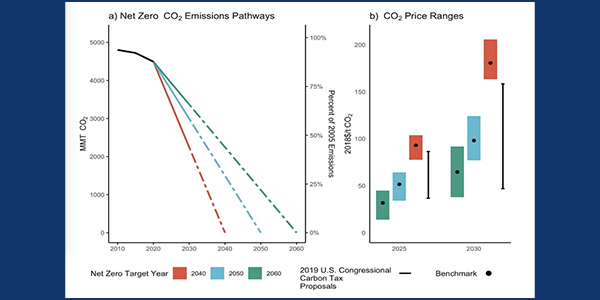Environmental policymakers should abandon the social cost of carbon (SCC) and adopt a more practical metric tied to net-zero-emissions goals, according to a new study.
The study, led by Noah Kaufman at Columbia University’s Center on Global Energy Policy and published in Nature Climate Change, notes that SCC estimates — intended to represent the “optimal” CO2 price that maximizes net benefits to society — range from “under $0” per ton of CO2 to more than $2,000/ton.
“The wide range of SCC estimates provides limited practical assistance to policymakers setting specific CO2 prices,” Kaufman says. Instead, Kaufman and his coauthors recommend what they call the “near term to net zero” (NT2NZ) approach, which they say can eliminate much of the uncertainty, although they acknowledge it “balances benefits and costs only imperfectly.”
The authors say the SCC is undermined by the large uncertainties over risk aversion levels, attempts to assign monetary values to noneconomic climate damages and the appropriate discount rates — the value placed on future generations.
The NT2NZ approach proposes a four-step methodology:
- Select a net-zero CO2 emissions date.
- Select an emissions pathway to the net-zero target that balances the risks of even higher temperature changes with the additional costs of decarbonizing faster.
- Estimate CO2 prices consistent with the emissions pathway in the near term (e.g., next decade).
- Periodically update steps 1-3 using an “an adaptive management strategy.”
“Focusing on the near term means that CO2 price estimates should not be unduly influenced by assumptions about the highly uncertain long-term evolution of technologies and behavior,” Kaufman said. “Adaptive management can enable jurisdictions to stay close to the desired emissions pathway without making policy details contingent on assumptions about highly uncertain long-term variables.”
To illustrate the approach, the study looked at three straight-line emissions pathways from 2020 levels to net-zero CO2 emissions targets in 2060, 2050 and 2040. It resulted in benchmark prices in 2025 of $32, $52 and $93 per metric ton (in 2018 dollars), respectively. The price roughly doubles by 2030, “reflecting a much higher annual growth rate than typical CO2 price estimates based on the SCC or rising at the rate of interest,” the authors write.
Complementary policies such as more aggressive energy efficiency measures and regulations that lead to higher coal retirements could lower the 2050 CO2 price by $10 to $20/ton, with the price rising by the same amount with less aggressive policies.
The authors acknowledge that uncertainties present in the SCC approach — such as near-term clean energy innovation and fossil fuel prices — also impact the NT2NZ method. “But the NT2NZ approach avoids much larger uncertainties, including assigning monetary values to climate change damages,” they say.
The Climate Leadership and Community Protection Act (CLCPA) signed by Gov. Andrew Cuomo last year requires the Department of Environmental Conservation (DEC) to establish a carbon price — based on either abatement or damage cost estimates — that state agencies can use to consider the societal value of actions to reduce GHG emissions in their decision-making.
The DEC this summer provided draft regulations on the value of carbon to fulfill the CLCPA requirements. The comments that the department receives will be part of the public record.
“It’d be great if the state took a look at our method when developing its [emissions] plan,” Kaufman told RTO Insider.
Pricing emissions, however, should not be conflated with spending on climate change, he said.
Speaking at a Sept. 9 webinar about the possibility of a green stimulus package from Congress after the presidential election, he said, “There’s a pretty big caveat: Spending on clean energy is a really ineffective way to reduce emissions, at least by itself.”
Kaufman recommended keeping expectations low for progress toward deep decarbonization.
“When you look at the data on the impacts of the nearly $100 billion in spending on clean energy from the 2009 stimulus, or the quarter-trillion dollars worldwide, you can find some really good outcomes for clean technology projects. But on emissions? No real evidence that it moved the needle,” Kaufman said.
Throwing money at clean technologies is not a climate strategy, he said. The core of climate policy strategies are policies that directly address emissions, such as regulatory standards and prices.
“The surest way to drive a climate policy analyst crazy is to describe a climate plan based on how much it’s spending,” Kaufman said. “Spending can be a great complement to climate plans, making them cheaper, more effective, more equitable. That’s what Europe is doing right now. But if you want to reduce emissions, regulate emissions.”





